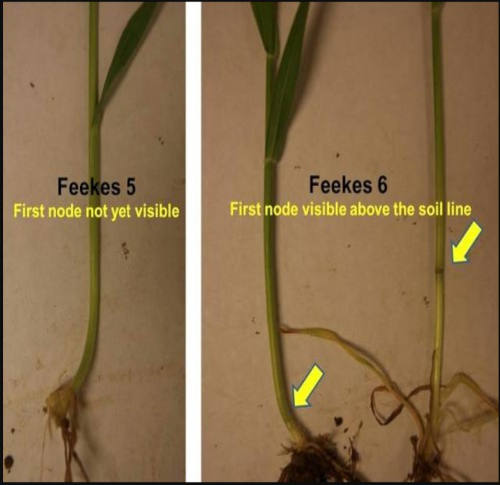By Laura Lindsey,Pierce Paul and et.al
It is important to correctly identify winter wheat growth stages to enhance management decisions, avoiding damage to the crop and unwarranted or ineffective applications. Remember, exact growth stage cannot be determined by just looking at the height of the crop or based on calendar dates. Remember to stage several plants from several areas within your field.

Here, we will focus on staging wheat Feekes 6.0 through 9.0.
Feekes 6.0: At Feekes 6.0 growth stage, nodes are all formed, but sandwiched together so that they are not readily distinguishable. The first node is swollen and appears above the soil surface. This stage is commonly referred to as “jointing”. Above the node is the head or spike, which is being pushed upwards eventually from the boot. The spike at this stage is fully differentiated, containing future spikelets and florets.
Growers should remove and carefully examine plants for the first node. It can usually be seen and felt by removing the lower leaves and leaf sheaths from the large wheat stems. A sharp knife or razor blade is useful to split stems to determine the location of the developing head. A video showing how to identify the Feekes 6.0 growth stage can be found here: https://www.youtube.com/watch?v=iukwznx4DPk
Feekes 7.0: At Feekes 7.0 growth stage, the second node becomes visible. This stage is characterized by the rapid expansion of the head and a second detectable node. Look for the presence of two nodes- one should be between 1.5 and 3 inches from the base of them stem and the other should be about 4 to 6 inches above the base of the stem. These nodes are usually seen as clearly swollen areas of a distinctively different (darker) shade of green than the rest of the stem. The upper node may be hidden by the leaf sheath; you may have to run your fingers up the stem to feel for it. If only one node is present, the wheat is still at Feekes 6.0 growth stage. Wheat will still respond to nitrogen applied at Feekes 7.0 if weather prevented an earlier application; however, mechanical damage may occur from applicator equipment. A video showing how to identify the Feekes 7.0 and 8.0 growth stages can be found here: https://www.youtube.com/watch?v=PZ7Lvsux1y8
Feekes 8.0: At Feekes 8.0 growth stage, the flag leaf is visible, but still rolled up. This growth stage begins when the last leaf (flag leaf) begins to emerge from the whorl. This stage is particularly significant because the flag leaf makes up approximately 75% of the effective leaf area that contributes to grain fill. It is therefore important to protect and maintain the health of this leaf (free of disease and insect damage) before and during grain development. When the flag leaf emerges, three nodes are visible above the soil surface. To confirm that the leaf emerging is the flag leaf, split the leaf sheath above the highest node. If the head and no additional leaves are found inside, Feekes 8.0 is confirmed and the grower should decide whether or not to use foliar fungicides to manage early-season and overwintering fungal diseases. Nitrogen fertilizer applications at or after Feekes 8.0 growth stage may enhance grain protein levels, but are questionable with respect to added yield. Moreover, additional N may increase the severity of some foliar diseases, particularly the rusts.
Feekes 9.0: Feekes 9.0 growth stage begins when the flag leaf is fully emerged from the whorl with the ligule and collar visible. From this point on, leaves are referred to in relation to the flag leaf (e.g., the first leaf below the flag leaf is the F-1, the second leaf below is F-2, and so forth). A video showing how to identify Feekes 9.0 and 10.0 growth stages can be found here: https://www.youtube.com/watch?v=OHGhq0qSM1o&t=22s
Source : osu.edu